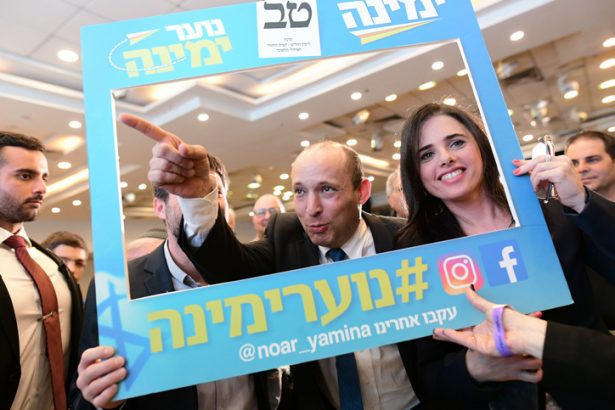The new Israeli Prime Minister Naftali Bennett is a ‘religious-Zionist’. But what does that mean and why has the national religious community split over the decision to enter coalition government with left-wing and Arab MKs? Fathom deputy editor Calev Ben-Dor, who spent his formative years and education within the religious-Zionist community, argues it is the social-cultural divide rather than the territorial debate that best explains the split between those religious-Zionists such as Bennett, Elkin, Stern, Tropper and Tamano-Shata who sit in the coalition and the Smotrich’s who so strongly opposes it. For the former, the willingness to ally with the Israeli left-wing is natural; they are allies and partners towards building a better Israeli-Jewish society. For the latter, more conservative group, they represent the decadent, secular, un-Jewish West. Journalist and best-selling author Yossi Klein Halevi tells Fathom, ‘the new government is the most powerful expression of ongoing social moderation of the national religious camp – which never lost its mainstream cultural identity. A clear majority of religious Zionists, including Naftali Bennett, are on the side of modernity. They want an Israel that is connected to the West, that values secular education, that is cutting edge in technology, and that is broadly democratic.’
It’s hard to see from the official photo of the newly sworn in Israeli government, but it includes five kippah wearers, all ostensibly members of the national religious movement.[1] In the front row is the new Prime Minister Naftali Bennett. The other four all stand alongside one another in the top right (in what one assumes was coincidental placement by the photographer). On the far right of the frame is Bennett’s partner in Yamina, Matan Kahana, the former F-16 pilot. To his left is Blue and White’s Yechiel (Chili) Tropper, a former member of the Labour party who has long been involved in social activist circles and education in the country’s periphery. Further left is Ze’ev Elkin, once a centrist Kadima MK, then coalition chairman under Likud and now part of the right-wing New Hope party. Next to Elkin stands Elazar Stern, who joined Yesh Atid after a long career in the IDF and who has previously called for greater public transportation on the Sabbath. While not a kippah wearer herself (in Orthodoxy, only men wear kippot), Blue and White’s Ethiopian born Pnina Tamano-Shata is also a member of the national religious community. Six national religious MKs, four different parties.
Lest one should think the government has a knitted kippa monopoly, Bezalel Smotrich and Itamar ben-Gvir of the self-proclaimed ‘Religious Zionist Party’ (RZP) led the opposition to its formation. In a fiery speech, Smotrich said the government excludes Jews, was dependent on terror supporters, and represents a chilul hashem a ‘desecration of God’s name.’
As spectrums go, the national religious community spans a particularly wide one – from those who term the Pride Parade a gathering of ‘perverts’ and ‘beasts’ on the one hand, to religious LGBT members on the other. From West Bank Rabbinical leaders who demand full annexation of the biblical heartland in Judea and Samaria to West Bank Rabbis, such as the late Menachem Froman, who met with Sheikh Yassin and believed the Holy Land should be shared. The ‘two Jews, three opinions’ joke is well known. But other than their head-covering, what connects these religious-Zionists?
Based on exclusive Fathom interviews and conversations, this essay explores these questions. It traces the history of religious-Zionism and its evolving relationship to territory and homeland. It examines the extent to which the religious component of the community’s belief is the driver for their political perspectives. It discusses the main crisis and disagreement within the community – which is not over the future of the West Bank but rather cultural-societal issues, with liberals against conservatives and those pushing greater integration within secular Israeli society battling against those promoting religious and sectoral interests. It is in this context that Bennett – and the opposition to his premiership on behalf of others in the religious-Zionist world – should be understood. Could it be that the election of the country’s first religious Prime Minister also signals the death knells of a united religious Zionist community?
Religious-Zionism and territorial maximalism
The first thing to say about the national religious community is that it is primarily right-wing when it comes to the Israeli-Palestinian conflict. A 2014 Israel Democracy Institute report stated that 80 per cent of the community were right-wing, with only 12 per cent defining as centrist and the rest left-wing. Menachem Lazar, a political pollster and PhD student of religious Zionist parties, told Fathom that data from the recent elections suggest the right-wing figure could be even higher. Lazar explains that in 2021, 60 per cent of the national religious voted for either Smotrich or Bennett; 20 per cent for Likud; and an additional 10 per cent voted for other right-wing or ultra-Orthodox parties.
Yet the national religious camp, which promoted a triangle of values – the Land of Israel, the People of Israel, and the Torah of Israel – was not always territorially maximalist. A contemporary of Herzl, Rabbi Jacob Isaac Reines proposed establishing a community in the Holy Land that would synthesise Torah and labour and that would be a ‘mercaz ruchani’ a spiritual centre. For Reines, the gradual resettlement of the Holy Land was worthy of the highest religious esteem. Yet at the fifth Zionist congress in 1901 in Basel, Switzerland, Mizrachi, the religious-Zionist group formed by Reines (an acronym of mercaz ruchani), supported Herzl’s search for a Jewish homeland outside of Palestine because they prioritised saving Jewish lives above any specific territory. While some – most notably Rabbi Abraham Isaac Kook – saw the return to Zion as constituting a process ultimately leading to messianic redemption, Mizrachi’s political leadership was primarily pragmatic and ‘dovish’. Before the Six-Day War, as the country collectively held its breath as Arab countries vowed genocide, it was the religious-Zionist leaders who opposed launching a pre-emptive strike. They subsequently even expressed opposition to invading the Old City.
1967: The Messianic Turn
Yet Israel’s victory in the 1967 war constituted a sea change for the national religious. They had always considered the return of Jewish sovereignty in Israel to be religiously significant – and signalling the ‘beginning of the flowering of redemption’. But the liberation of historic territories in Judea and Samaria electrified the community. Rabbi Tzvi Yehuda Kook, yeshiva [Torah academy] dean, ideologue and spiritual leader (and son of Abraham Isaac Kook) wrote that the victory signalled another step on the way to redemption. ‘On a deeper level’ Kook wrote, ‘both religious and secular are moving in unison toward the fulfilment of a single well-laid out messianic purpose. Whether they are aware of it or not, Divine Providence grips them, guiding them inexorably toward the final redemption of Israel.’ Part of this redemption, Kook believed was the conquest and settlement of the land. At other times, he argued that true redemption appears when the Jewish people fully inherit the land, and achieve complete sovereignty over it. As Aviezer Ravitsky explains in his Messianism, Zionism and Jewish Religious Radicalism, ‘the nationalist ideology of Rav Kook and his followers views the history of Zionism as an inevitable and decidedly messianic process, leading to the realisation of prophetic predictions’. Key to this process was the settling the newly liberated lands. The older generation of national religious leaders, more guarded and pragmatic were swept away by the wave of passion following Israel’s military victory. Sympathetic secular leaders, weak or ambivalent Labour-led coalitions and the more ideologically aligned Likud governments all facilitated the establishment of settlements led by religious Zionist pioneers in the decades following the war.
The more traditional, dovish views never disappeared. Netivot Shalom (Paths of Peace) was founded in 1975. The religious Zionist political party Meimad (a Hebrew acronym for ‘Jewish state, democratic state’) was founded in 1988 and led by Rabbi Yehuda Amital, the head of the Har Etzion Yeshiva in Gush Etzion in the West Bank. Amital would later join the Peres government following Rabin’s assassination. The Yud Bet BeCheshvan umbrella group was founded by religious Zionists in 2007 (the name marks the Hebrew date of Rabin’s death at the hands of a national religious assassin) in an attempt to counter what it saw as increased extremism within the community. Even Breaking the Silence, a (controversial) organisation of veteran IDF soldiers who recount their experiences of serving in the West Bank and Gaza, was partially founded by soldiers who grew up in religious Zionist homes. But as the electoral data suggests, these groups and their political opinions remained on the periphery of the community.
Theology and security in the politics of the National Religious
But to what extent does an individual’s religious beliefs influence their political opinions? Shaul Judelman,[2] a resident of Tekoa in the West Bank and Israeli co-director of the Roots, a grassroots movement of understanding, nonviolence and transformation among Israelis and Palestinians, believes most of the national religious community with right-wing views are less influenced by religious texts than by events on the ground. ‘It’s difficult to know to what extent one’s ideological pronouncements – such as opposition to withdrawal from the West Bank – come from security fears and how much is genuinely ideological’ he says in a phone call. ‘Most people’s political views aren’t necessarily based on what they see in religious texts. Rather they are influenced by their memories of people being killed … some members of the national religious camp even supported aspects of the Oslo Accords. If they no longer support land for peace, that’s not because of theological changes but rather due to events’.
Rabbi Shlomo Brin, a teacher at Yeshivat Har Etzion in Gush Etzion in the West Bank (and son-in-law of Rav Amital), agrees, distinguishing between a more ‘emotional or political right’ and an ‘ideological right’. ‘People in the national religious community are generally right-wing because places in Judea and Samaria such as Hebron and Bethlehem speak to them emotionally’ Brin tells Fathom. ‘They have an emotional connection to the land because of the Bible. But primarily their right-wing political positions are because they no longer believe peace is possible.’
Brin dates the change to the aftermath of the Rabin assassination in 1995. ‘In the 1990s the discourse was more halachic [based on Jewish religious law] over whether withdrawing from land was allowed or prohibited. People used religious phraseology as well as security considerations. Since Rabin’s assassination, they focus on security. Today, one hears religious prescriptions less and less – it’s now about whether one trusts the other side.’ Lazar agrees. For him, the distinction is between what he calls ‘pragmatic right-wing’ and ‘dogmatic right-wing’.
Religious and cultural disagreements within the national religious camp
Alongside the relative homogeneity regarding territory and settlements there are major religious and cultural disagreements in the community. There are arguments over personal autonomy versus rabbinic authority; the integration of ‘Western’/modern/secular values into one’s personal life; the extent to which religious Zionists should seek to cooperate and ally with secular Israeli Jews; and the relationship to the ‘other’ – whether that be those from non-Orthodox streams of Judaism, the LGBT community, Arab citizens of Israel and Palestinians, and the non-Jewish world in general. Indeed, Lazar argues that the main crisis within religious Zionism is the ‘liberal vs conservative divide’, or the ‘integration within Israeli society’ versus ‘narrow religious interests’.
Israeli journalist Yair Ettinger describes a ‘long series of ideological, ethical and halakhic discussions across the camp that touch on the “civil” rather than the political life’. The rise of feminism, the internet revolution, social media, and the erosion of Rabbinic authority all play into these discussions. In his book Unravelled, Ettinger sums these developments up with the phrase ‘the generation of privatisation in religious Zionism’. He notes the community is ‘getting stronger, diversifying, radicalising and moderating, becoming both more and less sectoral’. While it is no longer bound around one official theme ‘neither is it divided into two separate camps but rather scattered across a broad spectrum between conservatism and innovation’.
Judelman is a student of the late Rav Froman, who as mentioned earlier, met with Hamas leader Sheikh Yassin. A fascinating character with a flowing white beard that made him look like a Biblical prophet, Froman defied traditional stereotypes by being fully committed to the holiness of the land on the one hand, yet recognising the Muslim and Palestinian connection to the land on the other. For Judelman, ‘The difference between “the Smotrich type” [more conservative camp] and the more liberal aspect within religious Zionism is over the question of whether I hunker down and not allow reality to detract from my belief, or I say that this complexity is also part of God’s revelation; that while I’m not going to lose my compass, I’m going to honestly engage with it (whether that be secularism, homosexuality, or Palestinian nationalism). That side makes space for the world around us. It believes there is a redemptive opportunity to honestly engage with the “other” stories and “truths” around us including the Palestinian story. The more conservative side double down on our own Jewish story.’
‘Ideology often closes our eyes to reality’ Judelman says. ‘Rav Froman let reality challenge his ideology. He even saw a redemptive element in those challenges – a chance to redeem our Judaism. The source of truth isn’t just the book but what is going on right now. We can believe the Jewish people’s historical truth that we were here for thousands of years and that God promised us the land … but the moment I open my eyes I’ll see there are millions of Palestinians here too.’
While this type of thinking was always a part of the national religious camp, the miraculous victory in 1967 changed things, as discussed above. ‘That ability to break out of beliefs and work with reality is a legacy within Religious Zionism’ Judelman explains, ‘but in some ways we were blinded by the light of 1967. It stopped us from seeing clearly’.
Who is Naftali Bennett?
It is this social-cultural divide rather than the territorial debate that best explains the split between those religious Zionists such as Bennett, Elkin, Stern, Tropper and Tamano-Shata who sit in the coalition and the Smotrich’s who so strongly oppose them. For the former, the willingness to ally with the Israeli left-wing is natural. They are allies and partners towards building a better Israeli Jewish society. For the latter, more conservative group, they represent the decadent, secular, un-Jewish West. It’s difficult to determine the balance of forces between these groups. The conservatives, sometimes referred to as Chardalim (a cross between Charedi and dati-leumi – national religious – or those within the national religious community who seek to align themselves sociologically with an ultra-Orthodox type of isolationism) hold sway over the education system.
Journalist and best-selling author Yossi Klein Halevi tells Fathom ‘the new government is the most powerful expression of ongoing social moderation of the national religious camp – which never lost its mainstream cultural identity’. ‘A clear majority of religious Zionists, including Naftali Bennett, are on the side of modernity. They want an Israel that is connected to the West, that values secular education, that is cutting edge in technology, and that is broadly democratic.’ In fact, argued Klein Halevi, ‘Bennett is likely more comfortable with those Israelis who are committed to a sane Israel than he is to fellow religious Zionists whose vision is a fundamentalist Israel under permanent siege and at war with the world’. Gadi Gvaryahu, one of the liberal religious Zionist founders of the Yud Bet BeCheshvan umbrella group agrees. ‘Bennett undoubtedly sees a closer connection with [left-wing Labour MK and former elite IDF unit] Omer Bar Lev than with Kahanist supporter Itamar Ben Gvir – probably Smotrich too.’
Bennett is thus arguably the poster child for this type of territorially right-wing but socially-culturally engaged group of religious Zionists. He is a former high-tech entrepreneur who served in an elite IDF unit. He married a secular woman, yet maintains an Orthodox home. He also holds unapologetically right-wing territorial views. In a Fathom interview with me in 2017, Bennett said Israel should apply sovereignty in Area C, offer Palestinians living there full citizenship and allow Palestinians in Areas A and B to govern themselves, a plan he called ‘autonomy on steroids’.
Yet Jason Pearlman, a former Bennett advisor, cautions against viewing the new Prime Minister solely through the prism of the Israeli-Palestinian conflict. ‘As Education Minister, Bennett did tremendous amounts in Charedi and Arab schools. As Economy Minister he invested in the infrastructure of Rahat and Hura [two Bedouin cities]. As Minister for Jerusalem, he was behind the initiative to establish the egalitarian platform at the Kotel [for use by non-Orthodox streams of Judaism]. And as Diaspora Minister, he flew to Pittsburgh and stood side by side with Jews of every stripe after the massacre in the synagogue and called them his brothers’. Pearlman continued: ‘For Bennett, one can’t be a religious Zionist without believing in a national bond for the Jewish people wherever they are. That comes with a need and appreciation of mutual understanding and engagement as well as an approach to religious inclusivity.’ Indeed, it’s no coincidence that Bennett’s first political party was called Bayit Yehudi, a Jewish home. He included secular Tel Avivi Ayelet Shaked and later tried (unsuccessfully) to bring in the famous ex-footballer Eli Ohana. One of his Knesset aides was lesbian. His vision for the party was that it would include people who were not the same. He seeks engagement with wider Israeli society. It’s also no coincidence that many of these moves drew the wrath of Rav Zvi Tau, a major disciple of Rav Kook and one of the leaders of the more conservative camp.
In fact, the politically diverse composition of the new government and its reflection of more socially open values may be the primary reason for the deep anger within the conservative parts of the national religious camp against Bennett and Co. Rav Tau even issued a Halachic [Jewish law] ruling that it was preferable to ally with the Islamist Mansour Abbas’s Raam party than with the Israeli left. Smotrich called the coalition a desecration of God’s name. And while some of this was likely influenced by the bitterness of opposition, it suggests something deeper. For this group, the Israeli left – represented by the ‘childless by choice’ Labour leader Merav Michaeli (who – gasp! – dares to use the feminine form of Hebrew to refer to men and women) and the openly gay Nitzan Horowitz of Meretz – represents a disaster for ‘traditional Jewish and family values’. The cosmopolitan face of Israeli society – one that many within the national religious camp strive for – is anathema to the more conservative wing.
None of this is particularly new. When in the early 80s the Israeli novelist Amos Oz visited Yisrael Harel in the West Bank settlement of Ofrah, the influential settler leader told him that ‘Israeli-ness’ (rather than Zionism or Judaism or settlement) was simply a satellite of the West. It had no intrinsic value or uniqueness. Brin explains that for the Smotrich camp, liberal values ‘endanger the soul of the nation and the destiny of the Jewish state to be a Kingdom of priests and a holy nation [as commanded in the Torah]’. That the seemingly religious Bennett would ally with those secular liberals shows how far he has fallen.
What now?
That tension between these two groups will continue to play out. Gvaryahu sees the core of the debate as being over nothing less than Israel’s future. ‘Within religious Zionism, the battle is over the future of Israel as a Jewish and democratic state or as a Jewish and theocratic state’ he says. ‘This is the battle – both territorially and socially between moderates on the one hand and Rabbis such as Rav Ginsburg, Dov Lior and Smotrich’s Religious Zionist party on the other.’
Klein Halevi believes there may no longer be ‘any such thing as a united religious Zionist movement’ adding that ‘by choosing Meretz over Smotrich, Bennett put the final nail in that coffin’.
The national religious community has shaped parts of the Israeli cultural mainstream. But for Klein Halevi, the bigger question is whether it can now ‘embrace the consequences of Israel as a democratic state’. What makes this particularly difficult goes to the core of Zionism’s success – it created a country that is both a homeland for every Jew (regardless of whether they are a citizen) and a state for all its citizens regardless of whether they are Jewish.
Zionism, according to Klein Halevi ‘reconstituted Jewish peoplehood but also created a new people, called the Israelis. The national religious camp needs to simultaneously embrace both these Zionist achievements and own up to the complexity of Israeli identity. Even as they rightly insist on affirming the centrality of Jewishness within Israeliness, the national religious camp needs to internalise that Israeli doesn’t necessarily equal Jewish.’ Ultimately the extent to which the community can relate to and include the non-Jewish inhabitants of the Holy Land in the larger Israeli national tent may thus become its decisive test.
References
[1] This essay uses the terms national religious and religious-Zionist interchangeably. The latter term should not be taken to refer to Bezalel Smotrich’s political party, which is referred to as RZP. Similarly, the terms Rabbi and Rav are interchangeable – both mean Rabbinic teacher.
[2] Click here to read a Fathom interview with Judelman and here for an opinion piece by him.





































